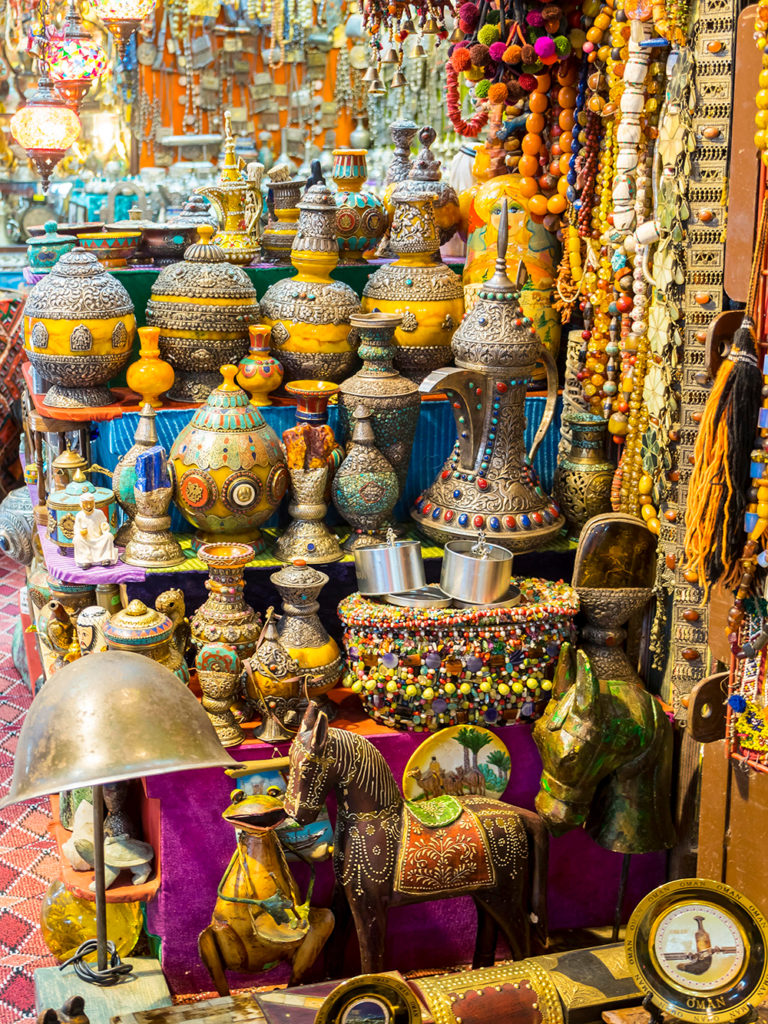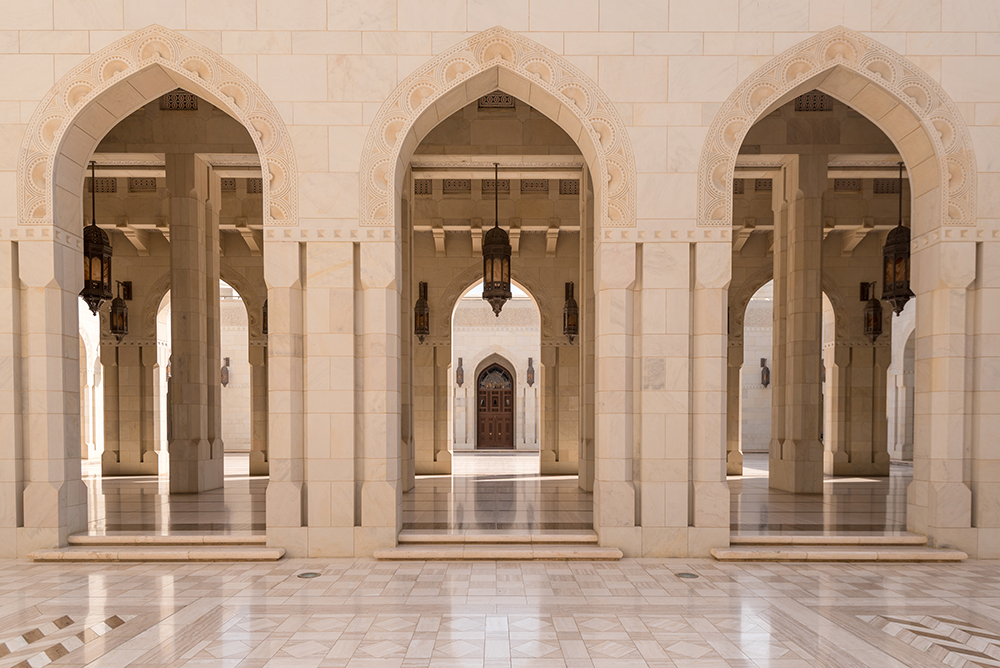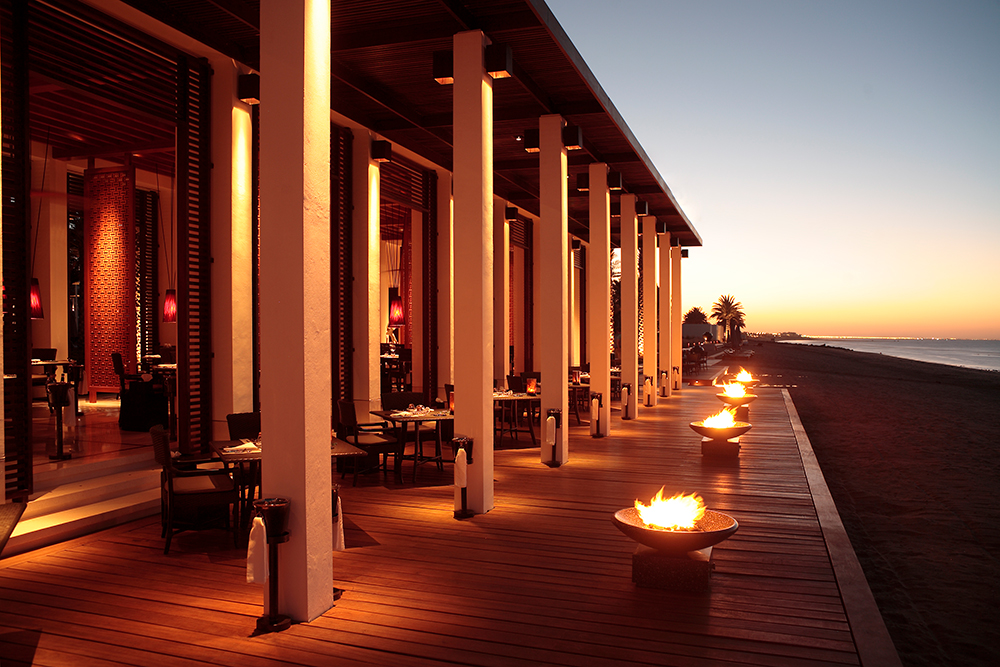Perched between Yemen, the United Arab Emirates, and Saudi Arabia, Oman is the gateway to the Arabian Peninsula. Yet up until the 1970 ascension of the current sultan, Sayyid Qaboos bin Said Al Said, the country was largely closed to visitors.
The Sultanate sits across the water from Iran, straddling the Gulf of Oman and the Arabian Sea. Briefly colonized by Portugal, the nation of under five million people has a long history as a trading outpost with Africa and India—Zanzibar was a territory for almost 200 years. This pluralism continues today: immigrants account for roughly 45 percent of the population. The result is a diverse culture, drawing on influences from three continents, that’s welcoming and warm towards foreigners.
Perhaps unsurprisingly, given the country’s unique geography, Omani cuisine is an opulent and complex bounty. Cumin, coriander, and ginger share kitchen space with green bananas, mint, coconut milk, chilies, dates, and saffron. The mountain ranges, fjords, coastal plains, and rolling desert, while breathtaking, are not ideal for farming. But the peaks have cavernous water-cut valleys—or wadis—and during monsoon season, many mountains turn lush shades of green and cloud forests form. And a trip though the labyrinths of any of the country’s souks—open markets—will easily sate one’s outstanding culinary desires. The publication of the first English-language Omani cookbook and a visit by the late Anthony Bourdain have raised the profile of the nation’s culinary offerings, but the simmering publicity has yet to boil over into the mainstream.

Speeding along the highway, travellers experience Muscat as a wash of low-rise white buildings butting up against the faun- and tawny-hued- sharp peaks of the Al-Hajar Mountains. It is a linearly designed capital set along the sea, with the old city enclosed by tall, ancient walls.
For early risers, the historic harbour in the old city is the place to greet the morning. Watch the sunrise and fishermen unload their catch at Port Sultan Qaboos before visiting the fish souk where you can marvel at 20-kilogram tuna and buy Omani prawns that vendors will happily cook for you.
If you feel like taking in marine life off the plate, a day excursion on the water is easy to arrange. Nomad Tours offers small boat trips for dolphin watching and snorkelling. The Arabian Sea feeds off the Indian Ocean and teems with wildlife. Whales, turtles, game fish, and 12 species of dolphins make their home there. After being transfixed by a school of acrobatic dolphins, submerging yourself in turquoise water to watch a florescent cornucopia of tropical fish dart among the coral is deeply relaxing.

Back on shore, a short walk along the Corniche—the seafront walkway dotted with 19th-century houses and minarets—will take you to one of the many entrances for Mutrah Souk. Here, inside the maze of stalls, you can shop for anything from antique rugs, pashminas, and copper coffee pots to ceremonial daggers (khanjars), gold, and tricycles. Haggling is expected. Frankincense—or luban—spills out of bowls and carefully sealed jars. Omanis use frankincense in everything from birth rituals to cosmetics, and its musky odour wafts through shops and homes. “Oman has always been a major crossroads for the trade routes,” says Felicia Campbell, author of the cookbook The Food of Oman: Recipes and Stories from the Gateway to Arabia. “There is a very heavy influence of East Africa, a heavy Indian influence, and then there is the Balochi people and a strong Persian influence.”
The Mutrah Souk is the largest souk in the country. It’s also an excellent place to come for spices. Dried chilli peppers hang like fairy lights across shop entrances. The earthy smells of clove, cardamom, and fenugreek waft through the air, and mustard- and orange-hued bins brimming with various masalas and biryani mixtures line the shelves. Among these supplies are the celebrated black limes of Oman. Carefully dried, these sour, musky fruits harken back to the country’s trading-port past and form a staple of many Omani dishes.
Another Omani delicacy is coffee. Dukanah Café in the Azaiba neighborhood is an ideal spot to experience it. Designed in the style of a traditional Omani home with clay walls, wooden ceiling beams, and ornately carved doors, it is a haven from the Muscat heat. Order a traditional coffee—or kahwa—infused with cardamom and served espresso- so-sized. For a cold drink, try their dried lemon tea (served over ice), a complex and pungently sour yet refreshing brew. For something sweet, there are quroos—a traditional tiny pancake—garnished with date honey and cream. Served hot enough to singe your fingers, the quroos have a nutty flavour that balances the sweetness of the dates.

Also in the Azaiba neighborhood, the Sultan Qaboos Grand Mosque is a breathtaking holy site that should not be missed. Opened in 2001, it is a quietly impressive example of modern Islamic architecture. The central dome arcs magnificently through the sky at 50 metres high. The four corner minarets are 45 metres high and made from a mixture of marble, wood, and sandstone—together with the central minaret, they represent the five pillars of Islam. The interior of the mosque is an equally formidable showcase of craftsmanship. The Persian carpet in the main prayer hall incorporates 28 colours and took 600 weavers four years to finish. Intellectually and spiritually engaging, the mosque is an inspiring stop for the religious and areligious alike.
Evening in Muscat is the perfect time to stroll by the sea and watch the shows as they lazily meander across the horizon. The sailing vessels look like they belong to another, bygone time, their curved sails cutting into the crimson sky as the call to evening prayer echoes out over the city. Dhow cruises are also available if you want to experience these majestic ships up close. If you would prefer an evening of classical music, the Royal Opera House Muscat is the Sultanate’s premier musical arts space—presenting such performers as Yo-Yo Ma and the London Philharmonic Orchestra—and it doubles as another fine example of contemporary Omani architecture.

Dining options are plentiful throughout the city. But for dinner with a view, it is hard to beat The Chedi. “People eat Omani food at home,” says Campbell. “A lot of Omani restaurants have opened up, but they will do a modern twist to make it appealing to the locals.” This venerable hotel, nestled in its own private beach in the Al Ghubra neighborhood, is well known for such lush eating. Dine amid arching palm trees while looking out over the water. The yogurt tandoori-spiced shrimp are infused with the fiery heat of serrano chilies and ginger; they pair nicely with one of the gin-soaked drinks on offer at the bar. And if you are still hungry, the frankincense ice cream, infused with the earthy caramelized resin, is the perfect ending note.
